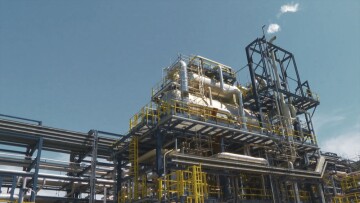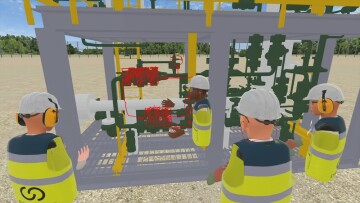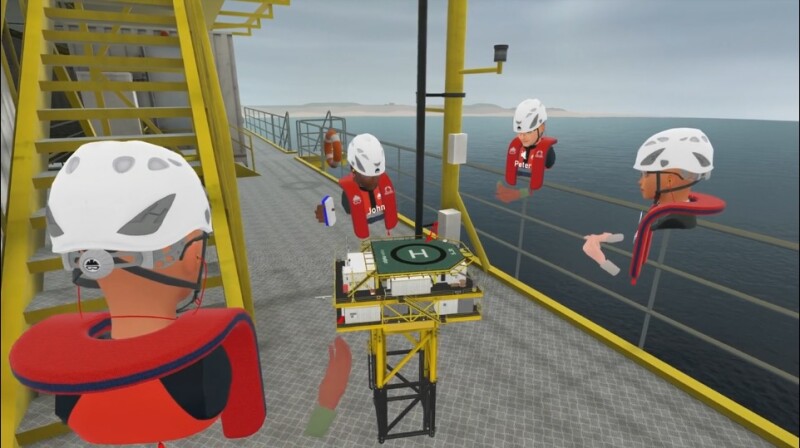Training is something every oilfield worker needs, so a high-tech approach using virtual reality (VR) aims to turn “have to” into “want to.”
The appeals of VR-based training include more-accurate and -consistent training, reduced costs, and increased user engagement.
Rob Houston, vice president of rig technology and service delivery at Precision Drilling, told JPT that new employee training can be overwhelming.

Traditional training gives employees “a substantial amount of information on something that they haven’t had a chance to physically get their hands on yet” in sessions akin to “death through PowerPoint,” he said. “Not everything gets absorbed.”
Precision wanted to create an immersive training environment rich with short, fun, and interactive modules that can be done remotely in the virtual world, he said. It’s a bonus, he said, that the generation entering the workforce is already comfortable in the virtual world.
“We wanted to create a world where, instead of me wondering why Employee 123 hasn’t completed their training, that instead, Employee 123 comes to me and wonders where the next training is,” Houston said.
Russell Whitney, Precision’s Industrial Internet of Things manager, told JPT the company started the VR training scoping process in fourth quarter 2023 and entered active development with partner SynergyXR the following quarter.
SynergyXR’s training development platform is rooted in the Unity game engine development platform.


Precision’s initial training focus is on the contractor’s EverGreen suite of environmental solutions, Houston said, with the intention of building out the training offering from there.
“Being a virtual world, you have a worksite that you can build, and then, as you want to add functionality to it or direct a couple modules of training in one certain aspect or another one, you still have the platform to work with. So, you’re not starting from scratch every time you want to touch something,” he said. “It’s an investment, and it’s a platform that you can build on to keep up with the times, as times are forever changing.”
Houston sees possibilities for the immersive training technology beyond employee training.
“If we can bring that to our investors, if we can bring that as a recruitment tool, if we can bring that to our customers, that’s just an overall win,” he said.
As of late June, Precision has offered the training at 20 worksites and nearly 150 personnel have used it. He said further deployment will follow as more modules are added.
For now, Houston added, the overall feeling is that Precision’s VR training approach has been a success.
“They’re asking for more, rather than us pushing compliance,” he said.
Whitney agreed, saying new trainees are so excited about the VR approach they sometimes want to skip the how-to navigation portion of the training.
“We want that excitement. We want to have fun,” he said.
And part of training is learning how not to do things.
“Because it’s a virtual environment, they can fail in a safe environment,” Whitney said. “Giving them the opportunity at the end to go and explore risk-free, that’s how they become that much faster at picking it up.”
Training Effectiveness
Faisal Irshad Khan, a professor in the Artie McFerrin Department of Chemical Engineering and director of the Mary Kay O’Connor Process Safety Center (MKOPSC) at Texas A&M University, told JPT that training has been identified as one of the largest contributors to industrial accidents onshore and offshore.

“To minimize these incidents, we need to increase the effectiveness of learning and practice,” he said.
The MKOPSC, which has a mission of saving lives through education, training, research, and development, has partnered with SynergyXR to enable development of knowledge-transfer technology and approaches that promote the safest execution of tasks, such as those required in the oil and gas industry, Khan said.
Traditional training has been linear, he said, with lessons typically provided through classroom teaching followed by hands-on practice. SynergyXR’s approach puts the training in a practical environment at a very early stage of the training journey, increasing the effectiveness of the lessons and practice, he said.
Some of Kahn’s PhD students have carried out studies that demonstrated tools such as VR enhance training effectiveness. In one study, one group received education only in the classroom, while the second group received classroom instruction as well as VR training. When the two groups faced test scenarios, there was a “dramatic difference” in the performance of the group that received both forms of training, he said.

“Tools like virtual reality provide us the venue where we can enable (trainees) to continuously learn and improve hazardous operation effectiveness without putting people into the high-risk environment,” he said. “That way, the workforce continues to learn and improve.”
And, if there is ineffectiveness in certain tasks or procedures, those can be improved, he said.
“Virtual reality provides the opportunity for the designers and the procedural people to look into more detail and improve their procedures and other elements, while the workforce also has a direct opportunity to visualize and operate in a closer-to-the-reality situation,” he said.
Training Development
Whitney said working with SynergyXR to create and implement the training was not a typical vendor/buyer relationship.
“They’re invested in our success,” he said. “There’s a lot of feedback back and forth.”
Mads Troelsgaard, CEO and cofounder of SynergyXR, told JPT, “We’re not stepping into this or other industries like the energy sector or oil and gas sector to become experts in oil and gas.”

Instead, he said, the focus is on enabling domain experts to easily create training programs.
“For us, it’s about software,” he said. “We want to provide them the tools to build their knowledge into AI and VR solutions so they can transfer that with these new technologies way faster, way more effectively than you can with any other technology in the world today.”
At the heart of SynergyXR’s platform is a no-code environment.
“We made it super simple for everyday users to utilize these technologies,” Troelsgaard said.
To create the training modules, users need 3D content, such as computer-aided-design models of equipment, 360-degree images, or 3D scans of equipment that can be imported into training platform.
“The learning content they already have, like presentations, videos, images, and more can be brought into the platform as well,” he said.
Blended learning is a common approach that combines classic learning with the VR world, he said.
“You have training material on an iPad or laptop, and then you can jump into the virtual world to get that experience of actually being there. When you go from theory into activity-based learning, it really sticks. That’s when you start to really remember the training and information,” he said.


Troelsgaard, for example, has never been on an offshore drilling rig, but, because of the different VR training modules he’s completed, he “knows where everything is,” he said. “I know how to step out of chopper on an oil rig, all the safety procedures you have to do when you step out of the chopper, where to put your bags, because I’ve done these kinds of training.”
The training can be done using laptops or tablets, but it’s most effective when used with a VR headset, he said. SynergyXR’s platform supports Meta, HTC, PICO, and Apple Vision Pro headsets.
“Once you have that, you’re up and running,” Troelsgaard said.


